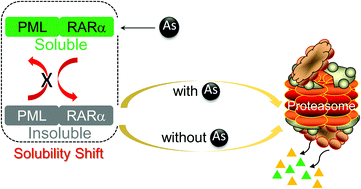Irreversibility of arsenic trioxide induced PML/RARα fusion protein solubility changes†
Abstract
Arsenic trioxide (As2O3) is one of the most effective drugs for the treatment of acute promyelocytic leukemia (APL), and induces the degradation of chimeric oncoprotein PML/RARα (P/R) and APL cell differentiation. Recent evidence has suggested that P/R fusion protein degradation by arsenic occurs through two steps, namely, rapid solubility change/shift of the P/R fusion protein following arsenic treatment (i.e., transfer of P/R protein from the soluble fraction to the insoluble pellet fraction), and subsequent degradation of these insoluble proteins. However, there is little information regarding the reversibility of arsenic induced P/R fusion protein solubility change as well as protein degradation in the insoluble fraction after removing arsenic. In this study, we used APL cell line NB4 or P/R and PML over-expressed 293T cells as well as HeLa cells to reveal the solubility change of P/R and PML by arsenic exposure, and further determined the fate of these insoluble proteins after the removal of arsenic. Here, for the first time, we found that arsenic induced P/R or PML protein solubility change is an irreversible process. Once arsenic induces a P/R or PML protein solubility change, these insoluble proteins could be degraded by the proteasomal pathway even without continuous arsenic treatment. However, PML and P/R proteins can be newly synthesized after the removal of arsenic, suggesting that great caution should be taken in the clinical therapy of APL patients before ending arsenic treatment.



 Please wait while we load your content...
Please wait while we load your content...